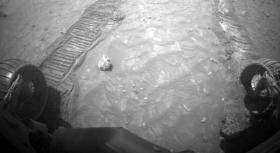Spirit Resumes Driving

(PhysOrg.com) -- NASA's Mars Exploration Rover Spirit resumed driving Saturday after engineers gained confidence from diagnostic activities earlier in the week evaluating how well the rover senses its orientation.
Spirit drove about 30 centimeters (1 foot) Saturday, during the 1,806th Martian day, or sol, of what was originally planned as a 90-day mission. The rover team had commanded a longer drive, but Spirit stopped short after its right-front wheel, which no longer turns, struck a partially buried rock. The rover drivers prepared commands Monday for the next drive in a slightly different direction to get around that rock.
A diagnostic test on Sol 1805 provided an evaluation of how accurately Spirt's accelerometers sense the rover's orientation or attitude. The testing was a follow-up to Spirit's mistaken calculation of where to expect to see the sun on Sol 1802. The sol 1805 results indicate the accelerometers may have a bias of about 3 degrees. This would explain why Spirit pointed a camera about three degrees away from the sun's actual position on Sol 1802. However, the Sol 1805 test also showed that Spirit's gyroscopes are operating properly, which convinced engineers that the rover could safely resume driving. Only the gyroscopes are used for orientation information during driving.
Diagnostic tests last week also checked possible explanations for behavior for one period of activity on Spirit's Sol 1800, when the rover did not save information into its non-volatile flash memory, so the information was lost when the rover next powered down.
"We may not find any data that will explain what happened on Sol 1800, but there's no evidence that whatever happened then has recurred on subsequent sols," said Jacob Matijevic of the rover engineering team at NASA's Jet Propulsion Laboratory, Pasadena. One possibility is that a cosmic-ray hit could have temporarily put Spirit temporarily into a mode that disables use of the flash memory. The team intentionally used that mode -- relying only on volatile random-access memory -- during recovery from a memory problem five years ago on Spirit.
Spirit is just north of a low plateau called "Home Plate." It spent 2008 on a north-facing slope on the edge of Home Plate so that its solar panels stayed tilted toward the winter sun for maximum electrical output.
Spirit drove down off Home Plate on Jan. 6, 2009. It subsequently checked whether a patch of nearby soil, called "Stapledon," had a high concentration of silica, like a silica-rich patch of soil Spirit discovered east of Home Plate in 2007. The earlier discovery was interpreted as evidence left by a hot-spring or steam-vent environment. Examination with Spirit's alpha particle X-ray spectrometer confirmed silica at Stapledon. This indicates that the environment that deposited the silica was not limited to the location found earlier.
Provided by NASA





















